All of their Strengths by Evil Mastermind
Some motherfuckers always gotta ice-skate uphill.
Original SA post ALL OF THEIR STRENGTHS: Some motherfuckers always gotta ice-skate uphill.Aw shit, man, you know the drill. There's monsters out there, in the shadows. Preyin' on people. Vampires. Werewolves. The Fae. Ghosts. Frankensteins. The whole damn lot. Normal people don't know about 'em until it's too late, and by then it's too late. In the spaces between the rain-drenched streets and the glow of the street lights, danger hides.
It's hiding from you. Because you are the most badass motherfucker in the room.
You ain't human. You ain't one of them either. You're somewhere in between. Half monster. Half human. Or maybe half-monster, half-other-monster, who the fuck knows. It don't matter. Just because you come from monsters doesn't mean you're a monster yourself. Except to the real monsters. You're the boogyman to the boogymen. Because of who you are, what you are, you can take the fight to the shadows. You've got the skills, you've got the gear, you've got the awesome sunglasses, you've got the techno soundtrack, you've got it all.
All of their strengths. None of their weaknesses.
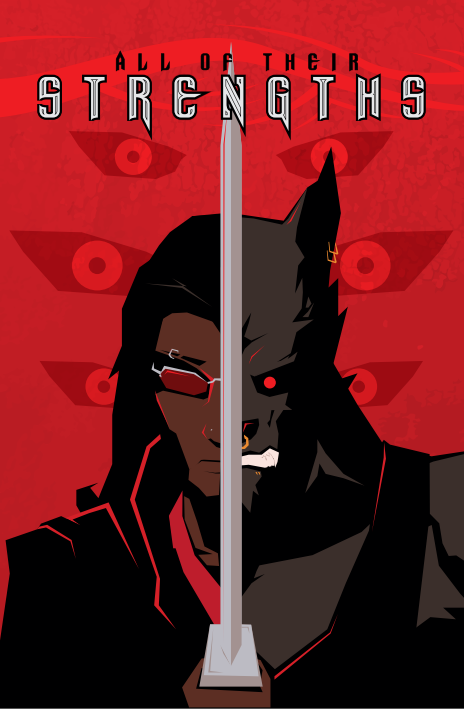
This one came at me out of nowhere, but come on, when a game's concept is "Blade II, but with more monsters you can be a half-breed of", how could I not take a look?
All of Their Strengths is a short RPG by Malachi Sharlow where you play hybrids; the offspring of monsters who fight monsters themselves via kickflips, katanas, and big-ass guns. And clearly this game is a "loving parody" of a genre that's been fertile ground for RPGs since Wesley Snipes' first Bloodbath. But does the game kick an entire nightclub's worth of vampire asses, or is it just another staked corpse in the shadowed alleys of the World of Darkness?
https://www.youtube.com/watch?v=n7vRbvXcjcU
Let's be honest. There's going to be a lot of Blade in this review.
Setting-wise, this is your standard 90's Dark Urban Ass-Kicking Fantasy deal. The world as we know it is actually chock full of various types of monsters, collectively known as Kindred. And there are a lot of Kindred out there apart from the standard monster trifecta of vampires/werewolves/Frankensteins. (And yes, they're called "Frankensteins" in the book.) You also have witches, mummies, angels, demons, zombies, ghosts, reapers (as in Grim Reapers), faeries, and deepfolk (deep ones).
Oh, and there are humans in there somewhere too.
In addition to the World of Darkness potpourri, you have your weird science (mostly used for hunting monsters) and your otherwise normal dudes using magic. Really the setting is basically a page long, based on the assumption that you've probably seen Blade more times than you'd care to admit. The "meat" of the setting is actually described in the various Kindred descriptions, each of which is about two pages long.
And honestly, I like the economy of description here. Informed settings aren't really things you see often in RPGs, where the general feeling is that more description = more interesting. But one of the strengths of games like, say, Dark Souls, is that the setting isn't explicit, it's inferred. You piece it together as you play from visual clues, brief conversations, and item descriptions.
For instance, at some point in history the Gates to Heaven and Hell were slammed shut, abandoning the angels and demons on Earth. This is mentioned in passing in the angel and demon descriptions, but the time frame, circumstances, and general effect on the world isn't talked about apart from an offhand comment from a demon that souls aren't going anywhere anymore. There's a UN-funded organization called "H.U.N.T." that exists to actively hunt down monsters, but it's never said how they operate, how powerful they are, or what the acronym stands for.
The Kindred descriptions are given in a very casual style, some more casual than others. But it's all clearly based on the common gamer understanding of how this type of setting works because, again, it's making the safe assumption that if you're reading an RPG with a title based on the Blade movies, then you know how this shit works.
quote:
After several decades of passive aggressive theological reconciliation, it is the official belief of the Hygh Counciel Vampyr that the modern vampire is descended from Vlad Tepes Dracula, who was, in fact, the reincarnation of Cain, who himself was an avatar of an even older pre-human deity primarily concerned with bats and blood-letting.
They also invented nightclubs, industrial music, and “fetishes, in the sexual sense” to hear them tell it. They like to act like they’ve had a huge impact on human society, that they’ve got this whole “dark puppet-masters” thing going, and, I guess it isn’t entirely untrue. They’ve got pretty solid records of their involvement in a lot of dark periods in human history, but it’s a lot less purposeful than they make it sound. It’s a vampire here, a group of ‘em there. It’s never the whole Kindred, and it’s rarely even consistent at the time - Hell, I got a stack of documents about vampires working on both sides of World War II. When it comes down to it, the Hygh Counciel’s first priority has always been to keep their whole species a secret, and any alterations it made to humanity’s course through history has always come second.

Character creation: "Still, my long years of dedicated study have given me the firm belief that anything is possible with enough pixie dust."
The first thing you do when making your character is figuring out which two creatures you're directly descended from. And you have the whole list to choose from. Want to be a half-vampire/half-werewolf? Sure, no problem. Half-zombie/half-demon? Why not? You wanna be a half-Frankenstein/half-angel? Fucking go for it, we're doing this. The things you have to consider are the strengths they give you, the weaknesses you'll have to deal with, and how cool the mix will be.
quote:
How cool is this mix? Is it dope as hell? Is it sweet, and/or sick? Would it definitely be the strongest and win all the fights, for sure? How rad would this thing look if you sketched it on the front of your notebook?
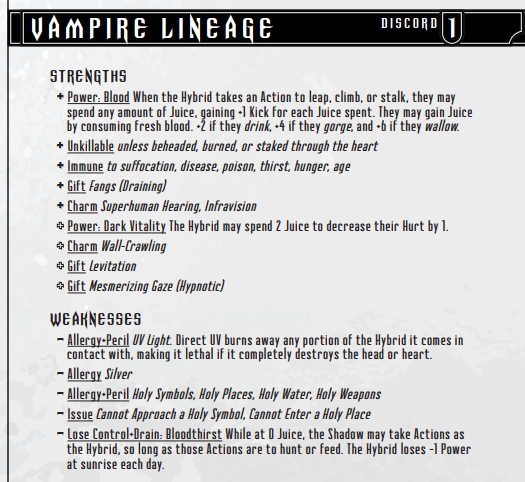
Behold...the vampire.
The base Strengths are the ones listed with the bold plus sign; you start with all that stuff. The ones with the hollow plus signs are ones you can get later. If any of your Strengths overlap, then the effects will generally stack. This can lead to fun combos like a Zombie/Mummy hybrid being unkillable unless both the brain and the heart are destroyed.
Strengths will have various keywords such as Gift, Charm, or Issue. These terms determine when and how an ability will work. For example, Gifts will increase the potential of actions, Charms will give a flat bonus, and Issues are things that the Hybrid are incapable of doing unless they really power through.
Once you have your two Lineages, you add up their Discord stats to see how many Weaknesses you have to take from between your two Lineages. The more powerful the Lineage, the more Discord (and probably more Weaknesses) it has.
You also have the option of taking "Human" as a Lineage. Humans don't get any Strengths because we're not cool enough, but humans do have a Discord of 0, which is good if you're looking to minimize your Weaknesses. But don't worry; later on it's possible to burn off your human heritage and gain another monster Lineage in its place, because why not?
Next step is coming up with your Origin; the tragic, impossible, brood-worthy reason you're half-deepfolk and half-Frankenstein. This is pretty much whatever you want, but the three most likely options are presented: forbidden love, strange accident ("I was bitten by a vampire while undergoing witch training, and, well..."), or lost predecessor (as in, you're actually one of the ancient whatevers that your Lineages descended from, only you've been locked away somewhere for centuries).
quote:
A Hybrid’s origin doesn’t have to be long, or even very detailed, but it does have to be special. Don’t spend the first twenty minutes of the movie on it, but maybe say enough about it to make a prequel later.
Once you have your tragic backstory, you assign your Stats. You have four: Built, Fast, Hot, and Sharp, which I hope I don't need to explain. Stats are rated from 0 to 5, and you start with 6 points distributed however you like.
Next up you have to pick your Scenes. Scenes are freeform skills along the lines of 13 Age's Backgrounds; they're freeform "things you are good at", but can also be locations that are important to you, subcultures you're a part of, things like that. These are only rated from 1 to 3, but a 1 is "very familiar" while a 3 is "mastery" so the scale's a bit narrow. And yes, one of your Scenes can be "Swords". At character creation you have 5 points to spend on up to five Scenes.
After that, you get to pick your three starting pieces of Gear.
quote:
Gear is all the cool, customized, expensive, hyper-advanced, or otherwise unique tools the Hybrid uses get the job done. Explosive silver throwing-stars, prototype automatic handgun, the UV grenades, the super-charged classic muscle car, or the sword-proof smart-fabric trench coat.
The next step is your Look, and I'm just going to screenshot this whole thing because I couldn't just pick a sample.
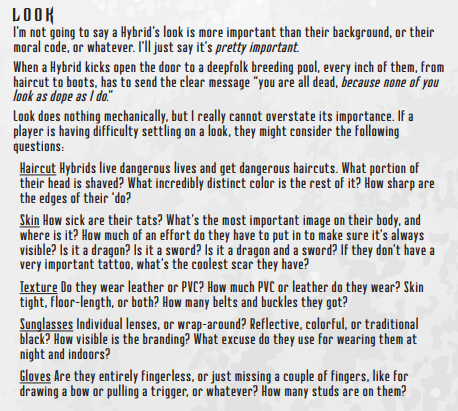
There is not a word of that I don't love.

Lastly, we have Power. Power is used to fuel some of your abilities, and comes in three flavors: Charge, Juice, and Amp. The difference between the three is that they all have different names.
Well, okay, there's a few differences. Various abilities might call for a specific type of power; for instance the Werewolf power Dire Form can use Amp or Charge to boost the user's abilities, but can't use Juice. Some Strengths just call for "Power", in which case you can pay it out of any pool. You can have a max of 5 Charge, 5 Amp, and 10 Juice for 20 Power all told. Power is gained based on your Legacies (in fact, some Legacies don't even use them), but you start each session with at least 2 Power of your choice.
Lastly, you start each session with a point of Destiny. Destiny is a sort experience point that you get once per session, and is used to "blow the cap" (which is to say, remove the maximum value) off a roll. When you do this, you can also advance your character in a few ways; you can increase one of your Stats or Scenes by 1, gain a new Scene at +1, "Phoenix" on a successful action to remove all damage taken or gain 10 Power on top of getting a new Strength, or "evolving" through (and I quote) " the consumption, transfer of energy, or sharing of blood with a Kindred of great power or plot significance" you can gain that Kindred as a new Lineage on top of what they already have. The longer you describe your transformation, the more Power you get.
And in a nice touch, if you haven't used your Destiny by the end of the session, you can spend it then to get +1 to a Stat or Scene, so you don't have to worry about wasting it.
Running the Game: "Look the metaphor ain’t great, but the threat is real."
So that's how you make your cool-as-fuck Hybrid. How do you do stuff?
Well, that's where things get a little more complicated. Or, at least, harder to explain. I'm going to break from my normal "tell you stuff in the order I read it" bit to explain it a bit clearer than the game does.
In AoTS, you're performing Actions. An action is basically one player or the GM (the "Shadow") doing one thing to one target. So when confronted with a locked door, "I kick the door off its fucking hinges" is one Action, but "I kick the door off its hinges and then spray the room with gunfire" is two. In the later case, you'd have to deal with the first action (kicking the door) first, then when that's resolved you can do something else. The guideline given in the book is that if you say "and" or "then" to chain something onto what you're doing, then that's a new action.
The other definitions for Actions are pretty straightforward and obvious, but are included for clarity: you can only take Actions with things you control (so the GM can't make a PC do something, unless a Weakness says otherwise), an Action has to be a quick thing, and you can't have two Actions going on at the same time. If timing does come up, the riskier action takes priority, and the GM's Action never has priority over a PC's Action.
One last important thing: Actions always succeed. I'm going to say that again, because it's important. Actions always succeed. When someone says their character does something, it happens. If I say I'm kicking that door off its fucking hinges, then that's what happens.
So wait, I hear you ask, if everything succeeds, then what's the resolution mechanic? Are success and failure a thing?
The answer is "yes, sort of". See, every Action you take generates something called Kick, which is best described as how awesome that thing you just did was. Every Action has a default Kick of 0, and assuming it's not an Action someone is trying to stop that's enough to succeed. If you have any Stats, Scenes, or Gear that would apply to your Action (such as "Awesome Sword" +1 when stabbing someone) then you add that value to your Kick. However, the maximum Kick you can have is equal to the Stat most relevant to the Action; so for swordfighting, it'd be your Fast stat.
Now, here's the thing. Whenever you take an Action, any other player, including the GM, can attempt to Foil that action. Foiling Actions are the "...but" attached to the end of the original player's Action. So to continue the door example, the Action would be "I kick the door off its fucking hinges" and a Foil Action would be "...but it turns out that door is double-reinforced steel". Likewise, a GM Action might be "The mummy cult leader plunges the dagger into the woman's chest!" and a PC could respond with "...but I hum a huge throwing star at the mummy's wrist, cutting it off!" Basically a Foiling Action is just something you're doing in opposition to someone else; or (to put it in another game's terms) the GM making a move in response to a player.
When you have an Action and a Foil going up against each other, the way you determine who succeeds is by who has the higher Kick. And boosting Kick is different for players and for the GM.
If a player is trying to Foil, then they calculate their Kick by adding any relevant Stats, Scenes, Gear, or Strengths to the base value. However, your Kick can't be higher than your rating in the stat most relevant to the Action. So if you're trying to hack a computer, then your maximum Kick is your Sharp. Spending a Destiny point on the roll will remove this cap.
If the GM is the one doing the Foiling, he needs to spend dice from his Threat pool. At the start of the session, the GM rolls two d6s and keeps them in this pool. When performing an Action, the GM can spend one of these dice to give his Action or Foil that die's value as Kick, but only to a maximum of 3.
The important thing about Foiling is that Foiling does not cancel the original Action. Anything that happens stayed happened; what being Foiled means is that the Action didn't give the player the desired outcome. Foiling kicking in a door doesn't mean the door doesn't go flying off its frame; what it means is that a second emergency security gate drops down in its place when the first one is gone.
So let's go back to the door example. The player wants to kick down a door. He's got a Build of 2 and no relevant Gear or Scenes to apply, so his Kick is 2. The GM's pool has a 3 and a 5. As it stands, the GM can just spend one of his dice to get Kick 3 and stop the character from kicking in the door. To succeed, the player would need to generate at least 2 more Kick.
How can the player do that? By rolling Risk. Risk is opening yourself up for trouble down the road. For each point of Kick you want, you roll a d6. The values on the dice aren't added to the Kick; you just one point of that per die you roll. Instead, these dice (with their rolled values) are added to the GM's Threat pool for him to use against you later. Fortunately, there's a table that gives you the appropriate Threat ratings of common foes, so the GM has a good idea of what an appropriate Threat is for common obstacles and foes.
If the GM gets two matching dice, they have the option of spending them to create a Doom. Dooms are major, serious threats that (among other things) let the GM get around his Kick ceiling. There's more to Dooms, of course, but I don't want to give away the whole system here.
If the action was something that would deal damage (physical, mental, social, or emotional) and it isn't Foiled, then it deals Hurt. Characters have five Hurt, and once that's filled they're dead (assuming they don't have a Strength that gives them a special "can only be killed by "X" condition). When you take damage, your Hurt meter fills to the amount of damage you just took, instead of adding up. So if you have 2 Hurt and take a 4-Hurt hit, you set your meter to 2. You always have a penalty to your Kick total equal to your current Hurt; the more beat-up you get, the more Risks you'll have to take.
That's the basic back-and-forth flow of the game. Players do things, the GM spends dice to create difficulties, and the players give the GM dice to succeed at difficult tasks, which sets them up for bigger threats later. Since everything automatically succeeds unless challenged, the game encourages over-the-top insane acts of badassery since it's damn near impossible to kill anything supernatural without doing a bunch of insane stunts with reinforced silver weapons and UV guns at your disposal.
Normally I'd save this for the end, but here's my biggest problem with the game: the gameplay flow is not described well. The main problem is that the mechanics are split across the book in three different places; the stuff about Actions and Kick are at the front of the book, the damage stuff is under character creation, and the Threat stuff is in the GM's section. And without the context of how the GM spends their dice to generate Kick, the basic Action/Kick mechanic doesn't make sense. All told the rules are about four pages long, but I had to read them a bunch of times to understand them. That being said, once I "got" it, it seemed pretty simple, but without actually seeing it in motion it's a bit hard to say.
Pretty much everything I've told you about up to this point is in the first half of the 66-page book. The remainder of the text describes the various Kindred, complete with social structures, general appearances, and the various Strengths and Weaknesses they have. I'll run throught the list and cover some of the high points.
One thing to bring up before we get to the meat, here: most of the Kindred have a Weakness they can take called "Lose Control". If you have this Weakness, the GM can force your character to take an Action of their choosing under specific circumstances. For example, the Vampire's "Loose Control" is Bloodthirst; the GM can take actions for the PC, but only if a) the Vamp is at 0 Juice, and b) those actions are to hunt or feed.
Vampires are, well, vampires. They claim to be "descended from Vlad Tepes Dracula, who was, in fact, the reincarnation of Cain, who himself was an avatar of an even older pre-human deity primarily concerned with bats and blood-letting." I already shared their stat block earlier so let's keep going.
Werewolves in this game are created via a disease that's transmitted either through offspring or via a bite or scratch. They don't really have an organized society; they prefer to hunt in family-based packs and keep more or less to themselves. Their big power is shifting into a gigantic humanoid wolf form and tearing shit appart.
quote:
Direform The Hybrid can assume a hulking, wolf-like “direform.” This takes at least one Action, but for each Action they use to describe this transformation, they may gain +1 Charge or Amp. While in direform, they add their Charge to Built, and their Amp to Fast, up to their normal maximum. When taking Actions to hunt, claw, bite, jump, or run, they add half their combined Charge and Amp to its Kick. Returning to human form takes only a single Action, but instantly reduces their Charge and Amp to 0.
Witches are, or at least were, humans that began training in mystic arts and herbology and all that New Age crap. Which sounds fine, until you realize that being around weird magical fumes and mushrooms all day can have a bad effect on you. Such as turning your skin green. And giving you warts. Or making your fingers and toes longer. You know, stuff like that. Unlike most other Kindred, witches are chosen. They're generally vetted through a series of tests (that the person may not even be aware they're taking), and if the potential witch passes, then they get the REAL initiation.
The witch's main ability is Ritualist. The witch gains a point of Charge for each Action they spend doing properly witchy spell prep, and then they can spend that Charge to activate an ability like Precognition, Psychokinesis, or Healing Touch. As they gain in power, they can start doing these spells without having to prep.
Mummies have been around a long time, and as such do not like change.
quote:
They aren’t just Egyptian, right? Like, there are mummies form just about everywhere. I’m Chinese. There are Chinese mummies. There was that movie, remember, the third one? It’s a global tradition. There’s a lot of history there.
And it’s all kings and queens and emperors and pharaohs. All rulers, right? And sometimes cats. Cats are a whole thing. But the majority, that’s leaders. Important people. So I told the lady, yeah, sure, I’m not using most of those organs anyway! A couple of them don’t even do anything!
So that happened, and I just feel like I’m part of this big tradition, and that’s cool. She keeps asking me to study all these scrolls though, and, like, asking me to copy news articles onto them, and I’m like, “I can send you the site,” and she just looks sad.
I think she's got a lot going on.
-Cynthia Xu, Recently Mummified
The central mummy ability is Grave Authority. If a mummy uses an Action to command someone and isn't Foiled, then the mummy can control that person for a few hours. They don't have a "Lose Control" weakness, but can take one that forces them to Defer to Cats: the mummy cannot take any action that would disturb a cat, and if a cat they've pissed off can see them, they lose their inherent "unkillable unless the heart is removed" Strength.
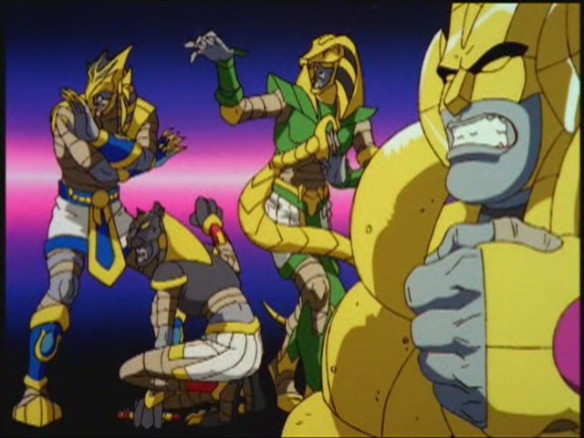
It would not surprise me if I'm the only one here who watched and enjoyed this cartoon.
Frankensteins are made, not born. Again, they're not really a "species" or "culture". They do have a yearly newsletter that gets around (spoiler: it's very dull) and a yearly get-together. Despite the general lack of mad scientists in remote castles in modern times, new Frankensteins keep appearing because they know how to make more of their kind. And there's nothing really stopping an inventive Frankenstein from seeing what happens if he uses a few parts from other Kindred in his latest creation.
The main Strength of Frankensteins is that they have Modular Organs. Which is a polite way of saying they can jam new organs into their bodies when the previous owner is done with said organ. Installing a new organ gets you one Amp, and have the option of spending a point of Amp instead of taking damage. Frankensteins are also unkillable as long as they have at least one Amp unless the brain is destroyed. Advanced powers include being able to add on extra limbs or a coaxial cable port. They also have the unsurprising Weakness of "Cannot Approach Fire", because as we all know, fire bad.
Angels and Demons are flip sides of the same coin. They were both kicked out of their respective afterlives after "the doors were slammed shut", and are now stuck wandering the world. Angels dedicate themselves to general freelance goodness and maintainign the status quo, whereas demons are all about random chaos. Angels see demons as unruly teens, and demons see angels as boring stuck-ups. That's probably a metaphor or something.
Angel and demon powers are pretty much the same, just infernal or diving (delete whichever is appropriate). Both beings can conjure divine/infernal fire to blast enemies, create shields, and form into cool-looking weapons Green Lantern style. However, in order to use their abilites, angels have to reveal their wings and demons have to reveal their horns. These features are also their weak points; as long as they're still attached, they're unkillable and immune to most human ailments.
Zombies are what they say on the label. OR ARE THEY?

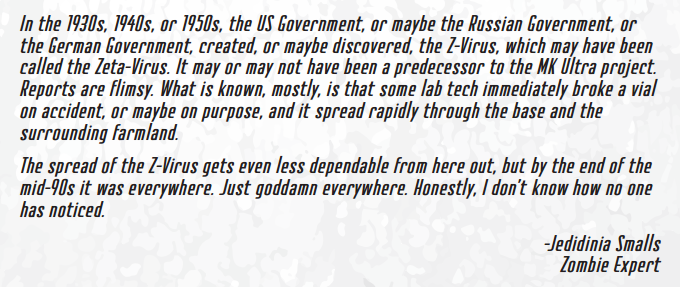
Regardless of where they come from, zombies are probably the most un-organized Kindred. They mostly appear as shock troops for other Kindred, mainly because nobody else likes them enough to do anything else with or for them. One thing that the movies got wrong is that zombies aren't mindless; they actually have access to a sort of hive mind that forms when they gather together. The problem is that the hive mind is sort of intelligence-reversing; the more minds are linked up, the worst the mental white noise is and the harder it is for individual zombies to think.
Zombies only form from corpses, but the Z-Virus will sit dormant in a person until they do die, at which point they'll immediately rise. Fun fact: it's estimated that as much as 40% of the world population actually carries the Z-Virus!
The zombie's main Strength is that they're Already Dead. Unless the brain is damaged, they can't die. That said, they don't have any inherent way to heal or regenerate. The hivemind also lets Zombie Hybrids control and take Actions with other zombies within 10 feet.
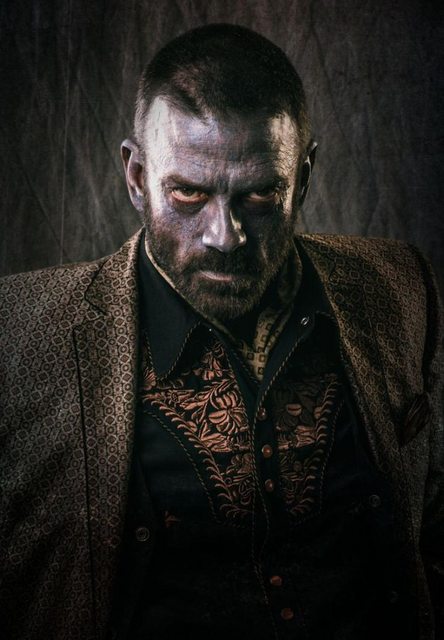
Not to say you can't still look good.
Ghosts are, again, what they say on the label. Nobody knows what causes people to come back as ghosts, let alone why they have ectoplasmic clothing. I mean, there's not much to say. They're ghosts.
Ghosts all get the Spectre ability, which lets them shift into their astral form. While astral, they're invisible 9 (the first attempt to see them with a Kick less than 3 automatically fails) and can pass through anything. More advanced ghosts can teleport or possess people, which lets them take Actions as the host. And yes, they can be thwarted by the ol' salt ring trick.
Reapers are...well...
quote:
Your standard reaper is between four and six feet from skull to tail, and weighing roughly twenty pounds. They resemble a cleaned, legless human skeleton with sharpened teeth and pinpoints of blue light visible within the eye sockets. Closer inspection will reveal a notable distinction in the form of an elongated tail bone tipped with a thin shard or stinger of what appears to be platinum.
When aggravated or engaged in reaping, the tail bone will extend to a length of up to the reaper’s height, and the stinger will flip out to reveal a micrometre-thick blade resembling a traditional farming sickle or scythe in shape.
The origins, goals, and organization of reapers is unknown. Recent H.U.N.T. projects have raised the theory that reapers are somehow "born" from humans, but given how dangerous they are it's hard to get close enough to actually study one, let alone ask it questions.
And yeah, they are fucking dangerous. The main reaper ability is the Retractable Tail Scythe: this is both a physical and astral object and completely ignores every immunity ability and bypasses any "unkillable except X" power, and has a default Kick of 3. However, if a reaper rolls a Risk of 6 while using the scythe, the reaper immediately takes 5 Hurt and the blade is dulled (losing all benefits except being physical and astral) until it can be sharpened on the bones of a reaper. Oh, and they can only be killed by the blade or bones of a reaper. Shockingly, reapers also have the highest Discord at 3, so you're taking a lot of weaknesses.
Faeries are not cute twikly fluttery things. They are, and I again quote: "bugs that spray drugs out of poison sacks in their lungs". They have very insectile features (particularly, multifaceted eyes), and are very much an endangered species due to mankind's constant dependence on iron. There are still Faery Courts, but a Court would be lucky to have a hundred members as opposed to the several thousand from the old days.
All faeries can use the Fae Face ability to look and sound like any human they've ever seen until they take Hurt. Like the ghost's invisibility, this automatically cancels any Kick 3 or less attempt to see through the disguise. They can also produce Pixie Dust, which inflicts such fun effects as sleep, memory wiping, or overpowering emotions when inhaled.
And lastly, there are Deepfolk.
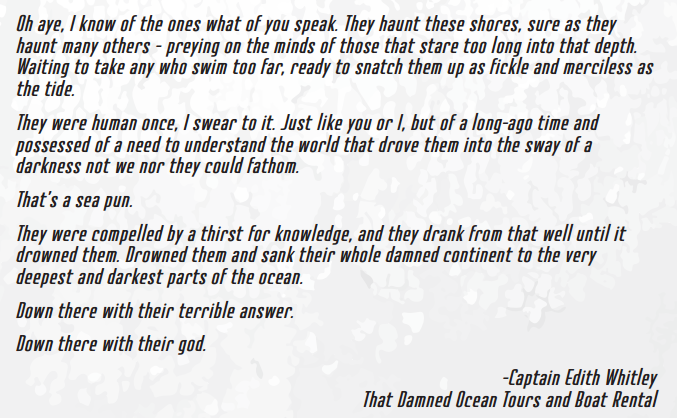
Yup, these are Deep Ones. I mean, what's a Gothic Urban Dark Fantasy Setting without at least one Lovecraftian thing, right?
Deepfolk look mostly like people, only with scaly skin and webbed fingers and toes. They live in sunken cities at the bottom of the ocean in what may or may not be the ruins of Atlantis, only coming to the surface during the full moon to...uh...y'know. Hang out. Meet people. People like them, who seek knowledge no matter the cost. And unto those people, they bestow the gift of knowledge. Terrible, terrible knowledge.
Deepfolk Hybrids can use the Merskin ability to take on the features of aquatic life by spending a point of Amp. They also have the Sea's Blessing, which gives them automatic Kick based on how wet they are. They also have one of the weirder weaknesses:
quote:
Lose Control+Issue: Deepmind While the Hybrid has 1 or more Amp, the Shadow may take Actions as the Hybrid to speak in vaguely poetic sentences or outright gibberish. They may have the Hybrid say a number of words equal to their Amp. The Hybrid has the Issue Do Not Contradict Deepmind Statements.
And with that, the book's over. Again, it's only 67 pages, half of which is Kindred descriptions and abilities.
--
Ages ago, I did a read-through of a "WoD heartbreaker" called "After Midnight". It was written by a minor industry "name" and I fucking hated it. The reason I hated it was because it started with a pretty valid thesis ("World of Darkness games are supposed to be personal horror but tend to devolve into Superfriends With Fangs"), and tried to address the idea by just throwing monster types together with shitty mechanics; it was basically someone looking at a project they didn't like and making fun of by making something similar but deliberately terrible to show how dumb he thinks the core idea of "everyone plays a monster" is. It's impossible to tell at that point if they're being petty or sarcastic or ironic or just stupid.
(The other reason I hated it was because the person who wrote it drove me nuts back in the day. Ceterum autem censeo Trollman esse delendum.)
This game? This game is the opposite of that.
It's a parody, yes, but it's a loving parody. It knows what beats to hit, be they in the lore, the presentation, or the ridiculous game terms. It also sees the whole "Superfriends With Fangs" problem, but addresses it by leaning into the skid. It doesn't try to "fix" the problem with the oWoD, nor does it shame anyone who played the game that way. Because let's be honest, for most of us that was how we played it. So instead of condemning the mindset, it embraces it. What's the only thing cooler than playing a badass tortured ass-kicking monster? Playing two at the same time! With more abilities!
Like I said, I feel like the game's biggest drawback based on a read-only pass is that the core system isn't well-explained. Once I understood how the back-and-forth worked, it seemed like it'd flow pretty well, but getting that flow down in the first place isn't easy. The author has said that he's working on an expanded version, so that might help with the clarity.
Still, I think the game's brevity works to its favor. It doesn't waste time explaining setting stuff you'd already know, instead giving you bits and pieces you can build off of in the Kindred descriptions. It's always heartening to see a game with an expected setting that doesn't hammer you over the head with details you don't care about or would already know. It's laughing with, not laughing at; it kids because it loves. And that's an important difference; it's what makes parody great.
Admittedly, I can't see this game lasting for a long-term campaign, but who cares? The life of a Hybrid is tragically short, despite their undying natures, and if you can't look completely badass during that time you're not worthy of either of the bloods flowing through your veins.
All Of Their Strengths is available on DriveThruRPG for $8 in PDF, $15 in print with the PDF. There's also a small expansion out just in time for Halloween that adds two new Hybrid options: Jackoleers and Skeletons.
Now if you'll excuse me, the techno music is starting up again. I need to put on my leather trenchcoat, grab my moonsteel katana, and kill a whole nightclub full of undead motherfuckers.
This is my gift.
This is my curse.